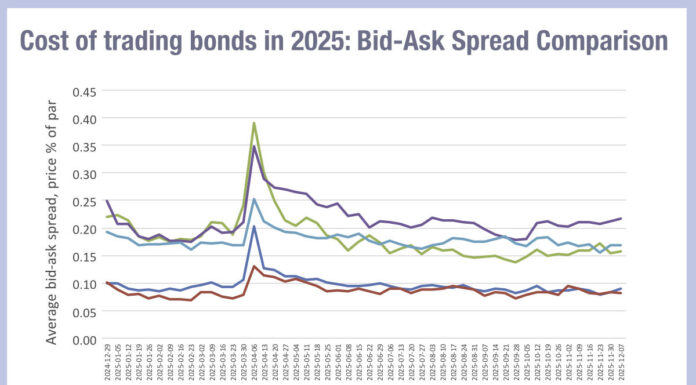Better execution through sell-side innovation
 Igor Burlakov, head of Capital Markets at Sova Capital sees the impact of lower rates and reduced volatility impacting trading desks over the next twelve months, creating a need from more efficient and innovative market making.
Igor Burlakov, head of Capital Markets at Sova Capital sees the impact of lower rates and reduced volatility impacting trading desks over the next twelve months, creating a need from more efficient and innovative market making.
How is the relationship between buy- and sell-side firms changing today in fixed income markets?
Historically the sell side has performed many roles for the buy side. The first role is primary market issuance. While it’s very important it hasn’t changed in the last five years, and we won’t see a revolution any time soon. We expect to see an increased number of issuances from September onwards. The second role is research provision, the third is agency transactions, and then risk taking and liquidity provision.
The big dynamics impacting this relationship are best execution for the buy side and the changes wrought by MiFID II. They have reduced the commission pool that the buy side can pay to the sell side, which creates the need to be more efficient. That is where technology deployment is increasing in importance.
Talking from our own experience, we have seen it as an imperative to deliver a broader range of trading opportunities across assets, using more technology and the same number of people.
As a result of these changing dynamics we have promoted two key initiatives within the firm. The first was to develop a cross asset approach; whereby a trader in fixed income is able to provide colour on local currency debt, on FX, and on rates, and that allows us to look at the broader market, and cover more asset classes with fewer resources. Such an approach has challenges, because the trader needs to be more empowered to deliver that broader service.
Technology is behind that empowerment. About 18 months ago we hired a four-person quantitative team who have mathematical rather than financial backgrounds, and this in-house expertise has allowed us to build quantitative and systematic solutions.
Such solutions have helped us identify effective execution mechanisms, new liquidity sources and hedging approaches. For example, if a buy-side firm approaches us to get a risk price on 10-yr Turkish hard currency bonds, it would typically be difficult to offload the entire risk from the book. By better understanding how assets correlate we can consider the adjustment we should take for a particular instrument and hedge the embedded risk using other routes: through the currency, local bonds, equity markets or a proxy via another correlated bond.
These new solutions have allowed us to provide liquidity and improve the execution of our market-making strategies by predicting and understanding fund flows, and understanding the correlation between assets.
What role is automation of trading having in this change?
Execution costs in fixed income are high; it is a mostly over-the-counter (OTC) market. We have seen the rise of electronic platforms like MarketAxess, however the majority of the trading activity is still through voice execution, and it is not that efficient. We are working to combine machine and human to analyse the new flows across EM bonds, sovereign names, corporate names, and automatically analyse the implications of news as it comes out and highlight those implications for the bond price to the trader. Then, by scanning the execution venues, we can highlight the best price and the best way to execute a particular idea.
New technology may identify the trends, but human beings still act on this information and make the decisions which facilitate the flows for the buy side more easily, however we no longer need to have as many traders covering a specific market. Margin compression will continue so we need to maintain service levels whilst being lean on the cost side.
Which trading challenges are your clients finding most difficult to overcome?
Liquidity is the most significant challenge. Clients are looking for the most efficient way to trade, with lower fees, either to a sell side firm or to a venue. When markets move fast, there are fewer liquidity providers. Sova is very capable in providing that liquidity. Our ability to hedge though other asset classes means we are able to support trading in less liquid instruments.
Many sell-side firms are less willing to carry risk or to hold it on their balance sheets for any length of time. As a result, bonds are like a ‘hot potato’, with assets bought and sold straight away.
We are a mid-sized investment firm, and our policy is to allocate capital to this business. By augmenting our human traders with technology we are providing liquidity and accommodating the risks that carry risk costs.
Buy-side firms are using multilateral trading facilities (MTFs) and all-to-all trading, however there is a gap in the flow of information between family offices, long-only firms, hedge funds, and we can sit between those firms in order to facilitate liquidity across that network. The increased use of MTFs and the movement away from bilateral trading is also helping us and our clients.
What should buy-side trading desks do to optimise their use of both high-touch and low-touch trading with broker counterparts?
Buy-side firms can become more systematic in their trading, quantitatively analysing inflows and outflows, and analysing risk premia on fixed income. In equity markets, value trades and momentum trades have long been used, and these factors should increasingly be assessed in fixed income and local market FX. Coming to understand those will help asset managers realize what drives their inflows and outflows. Given that, they can develop a systematic approach on how to manage their portfolios.
One consequence of the use of a systematic approach may be a lower turnover and greater efficiency, but it allows on the other hand for less discretion for the trader or portfolio manager to execute in the secondary market.
The development of MTFs has supported greater liquidity but they represent a small proportion of total turnover, so automatic screening of prices is very important to support effective price discovery.
Buy-side firms who are at the top of their game and can implement solutions to support these developments will see increased alpha.
How do you expect fixed income trading to evolve over the next 12 months?
We will continue to see similar trends as we have seen over the past 24 months in terms of market structure. Increased efficiencies through electronic execution and increased market share for trading platforms in corporate bond execution, which will support sell-side firms as the ultimate providers of liquidity.
We have seen significant changes over the past 12 months in terms of where rates are trading; a major rally across developed markets with rates for 10-years treasuries sliding from 3% to 1.5%, and significant moves on Euro rates. I would expect those trends to continue but in a less dramatic and less volatile fashion.
They will impact markets, as fixed income looks less attractive to end investors in terms of absolute return and potential returns. As a result, we could see greater yield hunt, with rotation from developed markets to equities or emerging markets where there is significant yield for investors.
As we will see less volatility on the rates front there will be significantly lower turnover in funds as allocation will change less. With rate trading as it is at the moment, we also expect to see big demand from corporate and sovereign issuers to capture the current rate environment in capital markets. That could potentially create some turnover, with some funds trying to capture the discount new issues are giving to secondary markets.
It could be a challenging 12 months for the sell side due to lower secondary market turnover, even with increased fees from primary markets. That will make the value of sell-side partners who can make markets, even during low liquidity periods, all the more important.
©The DESK 2019
©Markets Media Europe 2025












